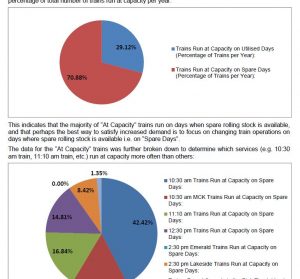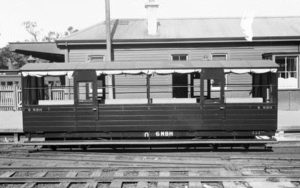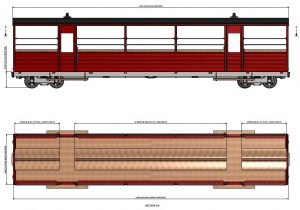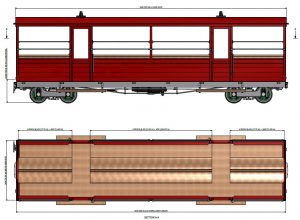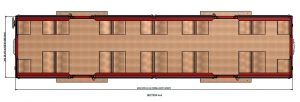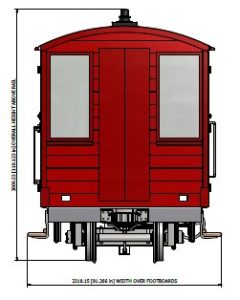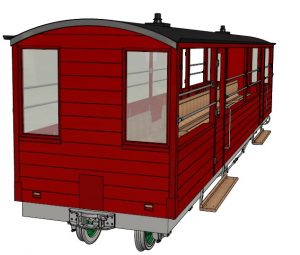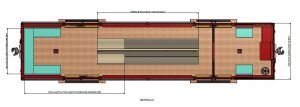I think it’s safe to say we can skip the why’s and wherefores’! Anyone familiar with Puffing Billy will know that passenger numbers are through the roof and our little trains are struggling to cope with the ever-increasing demand. At the same time, as much as we try and dissuade them, our marketing department insist on jetting off to the next growing overseas market, building relationships with tour operators who send us yet more passengers!
Two years ago, the Rolling Stock Branch, looking ahead as always, published a paper which identifies the current capacity constraints, and when they occur. The report, put together by Rob Reed, a Puffing Billy fireman and engineering student on work experience, details the times when all rolling stock is utilised, and during those times, how often we reach full capacity, as well as various operational ideas to increase capacity without the availability of more carriages.
The remainder of the report involved calculations to try and ascertain the maximum practical carriage length, and how this compared with the existing carriages in terms of capacity, weight and cost. If you consider that every carriage must have two bogies, 2 sets of couplers & draft gear, and 1 Westinghouse combination brake unit, then if you are trying to keep the train weight down whilst maximising passenger accommodation, you would try to make your cars as long as possible.
The cost of all these parts in comparison to the total cost of a carriage is also considerable, so there are several potential benefits to an increased length.
At this point is should be mentioned that, whilst reducing weight is beneficial, losing too much can have a detrimental effect. The Nadal formula, or L/V ratio, relates the lateral force of the flange against the rail to the downward force exerted on the rail by the wheels. If these forces are not considered at the design stage, there may be a tendency for vehicles which are too light to climb the inner face of the rail and come off the track.
So, where did that leave us? The report was issued to management and the Board, with a recommendation that the any new rolling stock be of a standard 11 metre length, some 4 metres longer that the original VR carriages, and giving a seating capacity of 42 passengers.
Our existing wooden bodied NBH carriages weigh somewhere in the region of 5 tons, with a capacity of 28 people, giving a mass per person of 178 kg. An 11 metre carriage with a capacity of 42 passengers would give an approximate mass per person of only 177 kg, despite the change from timber to steel construction.
At this point we were asked to put come concept designs together, based on the previous steel-bodied NBH cars, open carriages being considered the most popular with our passengers. This we duly did, and feedback received was that 11 metres was thought too much of a jump in length from our existing rolling stock, and would look out of place within a consist.
Back to the drawing board – or 3D CAD software in this case – and the result was a 9-metre carriage, this being the same length as our existing extended NBH carriages, 51 & 52, with seating for 34. An NBHC variation was included, combining an NBH with a guards compartment and wheelchair accommodation.
Various options were put forward at the concept stage but not incorporated into the final design, including:
- Two seating options, the first with longitudinal bench seats as per the existing cars, and the second with 2+1 transverse seating and end doors to allow for walk-through functionality. The walk-through option would allow for future inclusion of food and drink service on the trains, access to toilets, and maybe even a buffet or bar car. It was also considered advantageous to make access to seating easier, particularly for people with reduced mobility. 2 + 1 seating would negate the need for squeezing along the narrow gap in front of a bench seat already occupied with adults, kids, bags etc.
- End windows, which you might have picked up from the images, were originally just added to the disabled access end of the proposed NBHC type carriages. It was envisaged that these combined guards/disabled access vehicles would operate with the guards compartment on the in-board end, creating the effect of an observation end, and hopefully a much-improved visual experience for our disabled visitors.
- In a further iteration, and for consistency, these end windows were added to both ends of the NBH and NBHC type vehicles, with a view to increasing passenger security and safety. Whilst we can’t have a conductor in every carriage, guards and conductors must be as vigilant as possible, and these end windows would potentially allow staff to keep a better eye out along the train.
As part of the Rolling Stock Branch project control process, all groups and individuals considered to be stakeholders in the project were consulted, including the management team, Emerald Tourist Railway Board, Passenger Operations, Traffic Branch Committee, Puffing Billy Preservation Society Executive Committee, and the Heritage Advisory Committee.
Several consultation meetings collected much useful feedback which was taken into consideration as the concept design was firmed up into a final iteration. In particular, much discussion surrounded the layout of the guards compartments in the NBHC, seat layout and design, access and egress issues, and, most importantly, classification and numbering!
After many months of work, the Emerald Tourist Railway Board approved the detailed design, costing and manufacture of 12 new passenger carriages, 8 to be of the NBH type, and 4 to be of the NBHC type, all mounted on a standardised, light-weight 9 metre underframe and newly manufactured ‘Fox’ type bogies.
To be numbered 24 to 31, the new NBH carriages will weight approximately 6400 kg, and accommodate 34 passengers, giving a mass per passenger of about 188 kg.
The 4 new NBHC carriages will be numbered 1 to 4, and have an approximate mass of 6650 kg. With a capacity of 24 people, or 12 and 6 wheelchairs, this gives a mass per person of roughly 275 kg.
General Arrangement – NBH Class Carriage
Floor Plan – NBH Class Carriage
General Arrangement – NBHC Class Carriage
Floor Plan – NBHC Class Carriage
Part II – Coming Soon!



